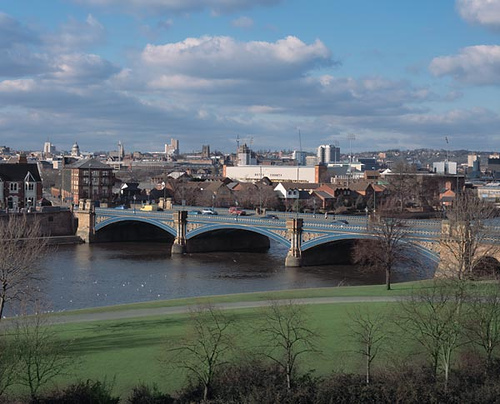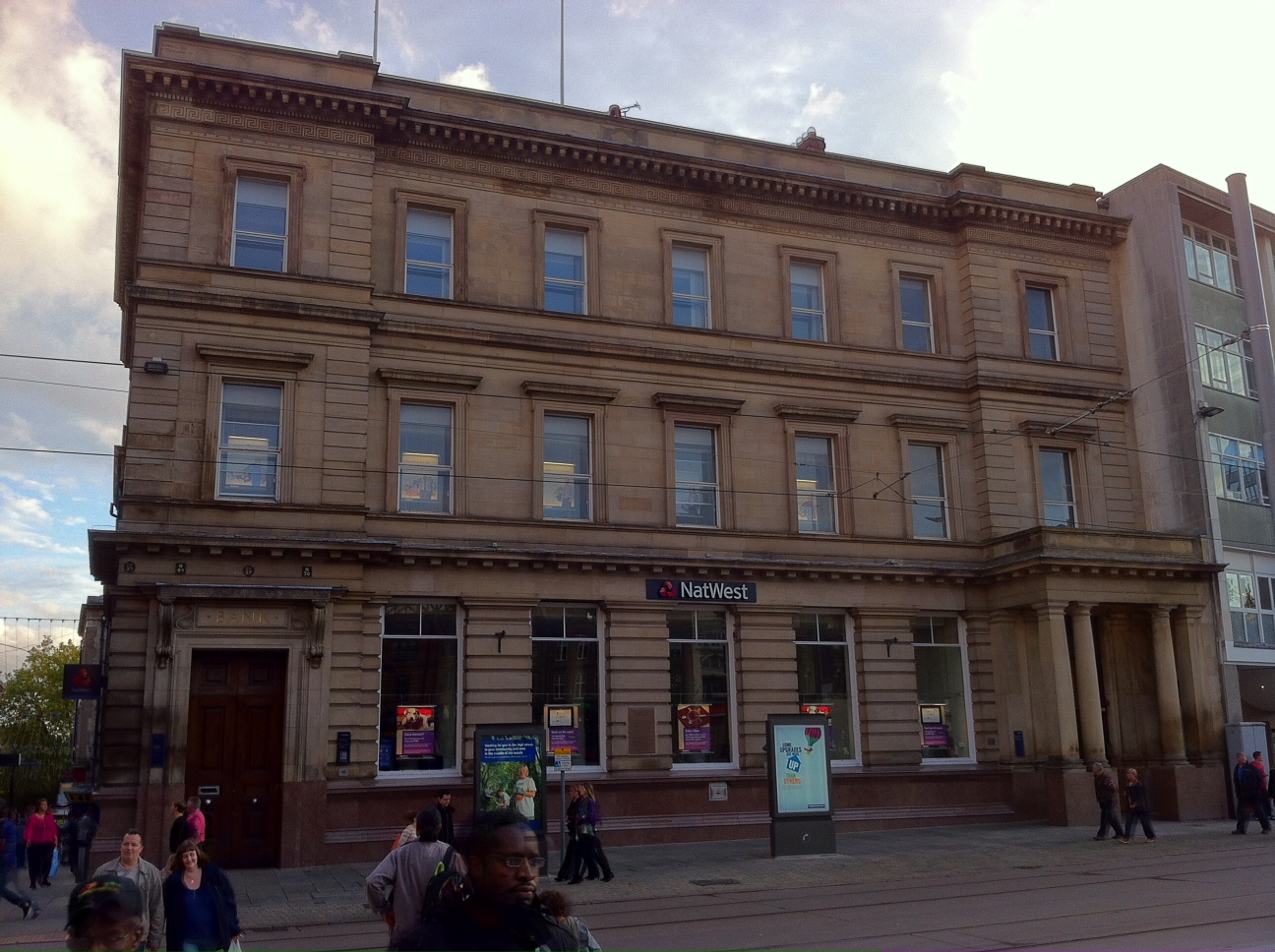|
South Parade, Nottingham
South Parade is a row of buildings in Nottingham City Centre forming the south side of Old Market Square, Nottingham which runs from Wheeler Gate to Exchange Walk. History In the thirteenth century this area was known as Timber Hill. Timber merchants stored and sold wood in the buildings here. As early as 1836 it was being known as South Parade. Notable buildings *1-3, by Evans and Jolley 1888 (Starbucks Coffee House in 2018) *4-9 Woolwich Equitable Building Society by Thomas Cecil Howitt 1936-37 *10-12 Norwich Union House by Evans, Cartwright and Woollatt 1957-59 *15 Smith's Bank Smith's Bank was a series of English banking partnerships in London and the provinces, all controlled by the Smith family that operated between 1658 and 1918. Although Smith's Bank was never a single entity, the first bank was established in N ... by George R. Isborn 1878 (National Westminster Bank in 2018) References {{Reflist Buildings and structures in Nottingham Streets in Nottingham< ... [...More Info...] [...Related Items...] OR: [Wikipedia] [Google] [Baidu] |
Nottingham City Council
Nottingham City Council is the local authority for the unitary authority of Nottingham in Nottinghamshire, England. It consists of 55 councillors, representing a total of 20 wards, elected every four years. The council is led by David Mellen, of the majority Labour Party. The most recent elections were held on Thursday 2 May 2019. History Nottingham was an ancient borough. It was reformed under the Municipal Corporations Act 1835 to become a municipal borough, and when county councils were established in 1889 the town was administered separately from the rest of Nottinghamshire, being made its own county borough. When Nottingham was awarded city status in 1897 the borough council was allowed to call itself Nottingham City Council. In 1974 Nottingham became a non-metropolitan district under the Local Government Act 1972, becoming a lower tier authority with Nottinghamshire County Council providing county level services in the city for the first time. The city was made a unitary ... [...More Info...] [...Related Items...] OR: [Wikipedia] [Google] [Baidu] |
Nottingham City Centre
Nottingham city centre is the cultural, commercial, financial and historical heart of Nottingham, England. Nottingham's city centre represents the central area of the Greater Nottingham conurbation. The centre of the city is usually defined as the Old Market Square, one of the largest surviving town squares in the United Kingdom. Covering about 12,000 square metres, it is within the boundaries of the centuries-old Great Market Place, which covered about 22,000 square metres. A major redevelopment of the Old Market Square was completed in March 2007. Many of the main shopping streets abut the square, which is dominated by Nottingham's city hall. The building's landmark dome can be seen for miles around. Much of the ground floor of the building houses the Exchange Arcade, a boutique shopping centre. A Bohemian quarter of the city known as Hockley has gained popularity in recent years, situated close to the Lace Market area. The northwestern end of the city centre is home to ... [...More Info...] [...Related Items...] OR: [Wikipedia] [Google] [Baidu] |
Old Market Square
The Old Market Square (Slab Square) is an open, pedestrianised city square in Nottingham, England, forming the heart of the city, and covering an area of approximately , or about 3 acres. It is one of the largest paved squares in the United Kingdom. Located in the heart of Nottingham City Centre, the square is bounded by Beastmarket Hill to the West, Long Row to the North, and South Parade to the South. The Eastern end of the square is dominated by the Council House, which served as Nottingham's town hall until 2010, when the administration moved to the newly acquired Loxley House on Station Street. The nature of the square means it is often used for large local events, fairs, concerts and exhibitions. History The early market square, from the 11th century until 1928, covered an area of about 5.5 acres (22,260 square metres), with its narrow western edge near Mount Street, broadening out to its eastern edge, adjacent to High Street. The then perimeter was formed by what ar ... [...More Info...] [...Related Items...] OR: [Wikipedia] [Google] [Baidu] |
Nottingham
Nottingham ( , East Midlands English, locally ) is a city status in the United Kingdom, city and Unitary authorities of England, unitary authority area in Nottinghamshire, East Midlands, England. It is located north-west of London, south-east of Sheffield and north-east of Birmingham. Nottingham has links to the legend of Robin Hood and to the lace-making, bicycle and Tobacco industry, tobacco industries. The city is also the county town of Nottinghamshire and the settlement was granted its city charter in 1897, as part of Queen Victoria's Diamond Jubilee celebrations. Nottingham is a tourist destination; in 2018, the city received the second-highest number of overnight visitors in the Midlands and the highest number in the East Midlands. In 2020, Nottingham had an estimated population of 330,000. The wider conurbation, which includes many of the city's suburbs, has a population of 768,638. It is the largest urban area in the East Midlands and the second-largest in the Midland ... [...More Info...] [...Related Items...] OR: [Wikipedia] [Google] [Baidu] |
Wheeler Gate, Nottingham
Wheeler Gate is a street in Nottingham City Centre between Old Market Square and St Peter’s Square. History In 1313 the street is referred to as Baxter Gate but shortly afterwards became known as Wheeler Gate, or Wheel Wright Gate, as the location of the wheel makers. It was wide at its narrowest point just below the Reindeer Inn, so the Town Council under took a project to widen it in 1885 to a uniform with the buildings on the eastern side being completely replaced. The roadway was wide with pavements on each side of width. In 1900, the conversion of the horse drawn tramway to electric power and extensions to the system built by the Nottingham Corporation Tramways included a double track route from St Peter’s Square along Wheeler Gate to join other tram lines in the Market Square. Notable buildings North east side *1, 3 and 5, Cavendish Buildings by John Howitt 1894. Grade II listed. *9 to 23 Premier House by John Howitt ca. 1900 Grade II listed. *25 to 29 by Robe ... [...More Info...] [...Related Items...] OR: [Wikipedia] [Google] [Baidu] |
Thomas Cecil Howitt
Thomas Cecil Howitt, OBE (6 June 1889 - 3 September 1968) was a British provincial architect of the 20th Century. Howitt is chiefly remembered for designing prominent public buildings, such as the Council House and Processional Way in Nottingham, Baskerville House in Birmingham (first phase of the unrealised Civic Centre scheme), Newport Civic Centre, and several Odeon cinemas (such as Weston-super-Mare and Bristol). Howitt's chief architectural legacies are in his home city of Nottingham. He was Housing Architect for the City Council, designing municipal housing estates which are often considered to be among the finest in terms of planning in the country. Early years Howitt was born at Hucknall, near Nottingham and educated at Nottingham High School, leaving in 1904 to be apprenticed to the prominent Nottingham architect, Albert Nelson Bromley. Bromley was architect to the Nottingham School Board and did extensive work for the Boots Company. In 1907, Howitt studied briefly at ... [...More Info...] [...Related Items...] OR: [Wikipedia] [Google] [Baidu] |
Evans, Cartwright And Woollatt
Evans, Cartwright and Wollatt was an architectural practice based in Nottingham from 1948 to 1961. History The practice was established in 1948, based at 6 Clarendon Street, Nottingham, and evolved from Evans, Clark and Woollatt after John Thomas Clark retired in 1940. Thomas Nelson Cartwright (1905-1984), formerly of Bromley, Cartwright and Waumsley had joined the practice. They specialised in modernist architecture, mostly built in reinforced concrete. In 1961 the practice changed name again to become Cartwright, Woollatt and Partners. Works *Portland College Mansfield 1949-50 *St Mary’s Church, Beeston Rylands 1951-52 *Floor Malting, Grimsby 1953 *Technical Book Department, Portland Building, University of Nottingham 1953-54 *Tetley’s Brewery Malting House, Leeds 1955 *Norwich Union House, 10-12 South Parade, Nottingham 1957-59 *Office Building, Park Row, Leeds 1958-59 *15 Cavendish Crescent South, The Park Estate, Nottingham 1960 Alterations, additions and conversion o ... [...More Info...] [...Related Items...] OR: [Wikipedia] [Google] [Baidu] |
Smith's Bank
Smith's Bank was a series of English banking partnerships in London and the provinces, all controlled by the Smith family that operated between 1658 and 1918. Although Smith's Bank was never a single entity, the first bank was established in Nottingham by Thomas Smith; often dated to 1658, it is believed to be the first bank to be formed outside London. Smith's grandson, Abel Smith II, substantially increased the scale of the enterprise, opening banks in Lincoln and Hull and, most importantly, the London firm of Smith & Payne. Other banks were later opened or acquired in the east midlands area.J. Leighton Boyce, ''Smith's the Bankers 1658–1958'' (1958). The bank lost its direction in the late nineteenth century and its solution was to merge with the Union Bank of London in 1902, forming the Union of London & Smith's Bank. This in turn was acquired by the National Provincial Bank in 1918, which merged into today's National Westminster Bank in 1970. History Early years Th ... [...More Info...] [...Related Items...] OR: [Wikipedia] [Google] [Baidu] |
Buildings And Structures In Nottingham
A building, or edifice, is an enclosed structure with a roof and walls standing more or less permanently in one place, such as a house or factory (although there's also portable buildings). Buildings come in a variety of sizes, shapes, and functions, and have been adapted throughout history for a wide number of factors, from building materials available, to weather conditions, land prices, ground conditions, specific uses, prestige, and aesthetic reasons. To better understand the term ''building'' compare the list of nonbuilding structures. Buildings serve several societal needs – primarily as shelter from weather, security, living space, privacy, to store belongings, and to comfortably live and work. A building as a shelter represents a physical division of the human habitat (a place of comfort and safety) and the ''outside'' (a place that at times may be harsh and harmful). Ever since the first cave paintings, buildings have also become objects or canvasses of much artisti ... [...More Info...] [...Related Items...] OR: [Wikipedia] [Google] [Baidu] |







